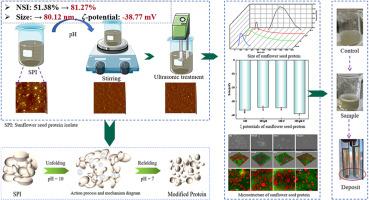Synergistic modification of sunflower seed protein by pH-cycling and ultrasound to improve its structural and functional properties
IF 11
1区 农林科学
Q1 CHEMISTRY, APPLIED
引用次数: 0
Abstract
Sunflower seed protein (SPI) is a high-quality plant-based protein with balanced nutrition, low allergenicity, and excellent sustainability. However, its limited solubility hinders the full expression of its functional properties, thereby restricting its broader application in food processing. To address this issue, SPI was modified via a synergistic treatment combining pH-cycling and ultrasound in this study, and its modification mechanism and functional properties were comprehensively evaluated. The results indicate that the combined treatment induced protein structural aggregation-disaggregation-rearrangement, significantly enhancing SPI solubility to 81.27 %, representing a 58.14 % increase compared to unmodified protein. During modification, pH-cycling treatment converted SPI molecules into a molten globule state, while ultrasonic cavitation and shear forces effectively disrupted protein aggregates. This led to increased exposure of chromophores on side chains, enhanced fluorescence intensity, reduced particle size to 81.08 nm, and increased ζ-potential (−38.77 mV), thereby improving system stability. The modified SPI exhibited a higher enthalpy change (ΔH = 3.58 J/g), along with markedly improved functional characteristics: foaming capacity and foam stability increased by 2.29 times and 2.69 times, respectively; emulsifying activity and stability reached 6.23 m2/g and 88.72 %; and oil-holding capacity was enhanced to 5.52 g/g, representing 2.73 times increase. Overall, the synergistic pH-cycling and ultrasound modification proved highly effective in improving the solubility and functional performance of sunflower seed protein, offering promising potential for its application in advanced food systems.

利用ph循环和超声对葵花籽蛋白进行协同改性以改善其结构和功能特性
葵花籽蛋白(SPI)是一种高品质的植物蛋白,营养均衡,过敏性低,可持续性好。但其溶解度有限,阻碍了其功能特性的充分发挥,从而制约了其在食品加工中的广泛应用。针对这一问题,本研究采用ph循环与超声协同处理的方法对SPI进行了改性,并对其改性机理和功能特性进行了综合评价。结果表明,复合处理诱导蛋白结构聚集-分解-重排,显著提高SPI溶解度,达到81.27%,比未修饰蛋白提高58.14%。在改性过程中,ph循环处理将SPI分子转化为熔融球状状态,而超声波空化和剪切力有效地破坏了蛋白质聚集体。这使得侧链上的发色团暴露增加,荧光强度增强,颗粒尺寸减小到81.08 nm,并增加了ζ电位(- 38.77 mV),从而提高了体系的稳定性。改性后的SPI具有较高的焓变(ΔH = 3.58 J/g),功能特性得到显著改善:发泡容量和泡沫稳定性分别提高2.29倍和2.69倍;乳化活性和稳定性分别达到6.23 m2/g和88.72%;储油能力提高到5.52 g/g,提高了2.73倍。综上所述,酸碱度循环和超声修饰对改善葵花籽蛋白的溶解度和功能性能非常有效,在先进食品体系中具有广阔的应用前景。
本文章由计算机程序翻译,如有差异,请以英文原文为准。
求助全文
约1分钟内获得全文
求助全文
来源期刊

Food Hydrocolloids
工程技术-食品科技
CiteScore
19.90
自引率
14.00%
发文量
871
审稿时长
37 days
期刊介绍:
Food Hydrocolloids publishes original and innovative research focused on the characterization, functional properties, and applications of hydrocolloid materials used in food products. These hydrocolloids, defined as polysaccharides and proteins of commercial importance, are added to control aspects such as texture, stability, rheology, and sensory properties. The research's primary emphasis should be on the hydrocolloids themselves, with thorough descriptions of their source, nature, and physicochemical characteristics. Manuscripts are expected to clearly outline specific aims and objectives, include a fundamental discussion of research findings at the molecular level, and address the significance of the results. Studies on hydrocolloids in complex formulations should concentrate on their overall properties and mechanisms of action, while simple formulation development studies may not be considered for publication.
The main areas of interest are:
-Chemical and physicochemical characterisation
Thermal properties including glass transitions and conformational changes-
Rheological properties including viscosity, viscoelastic properties and gelation behaviour-
The influence on organoleptic properties-
Interfacial properties including stabilisation of dispersions, emulsions and foams-
Film forming properties with application to edible films and active packaging-
Encapsulation and controlled release of active compounds-
The influence on health including their role as dietary fibre-
Manipulation of hydrocolloid structure and functionality through chemical, biochemical and physical processes-
New hydrocolloids and hydrocolloid sources of commercial potential.
The Journal also publishes Review articles that provide an overview of the latest developments in topics of specific interest to researchers in this field of activity.
 求助内容:
求助内容: 应助结果提醒方式:
应助结果提醒方式:


